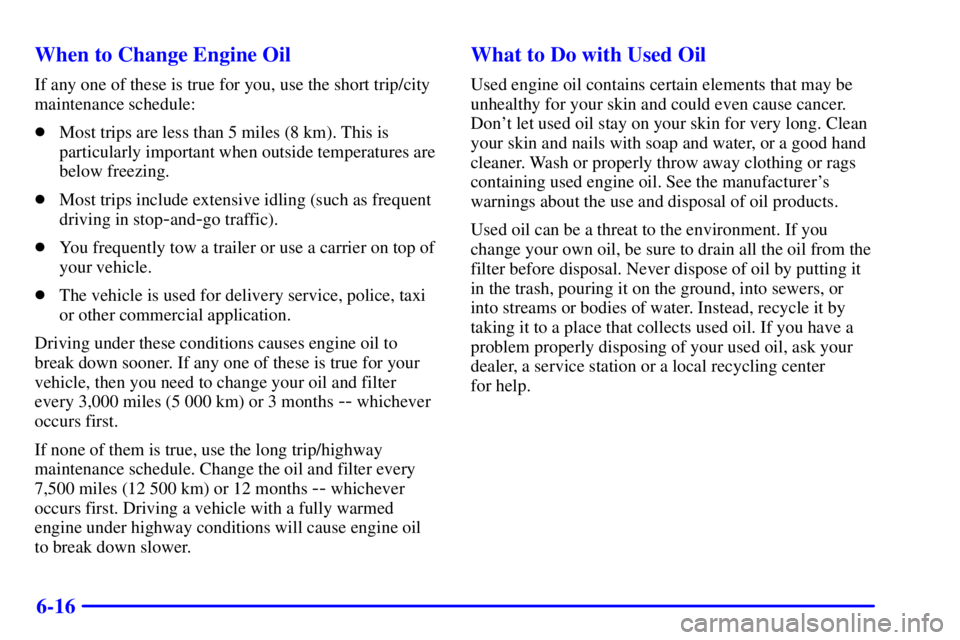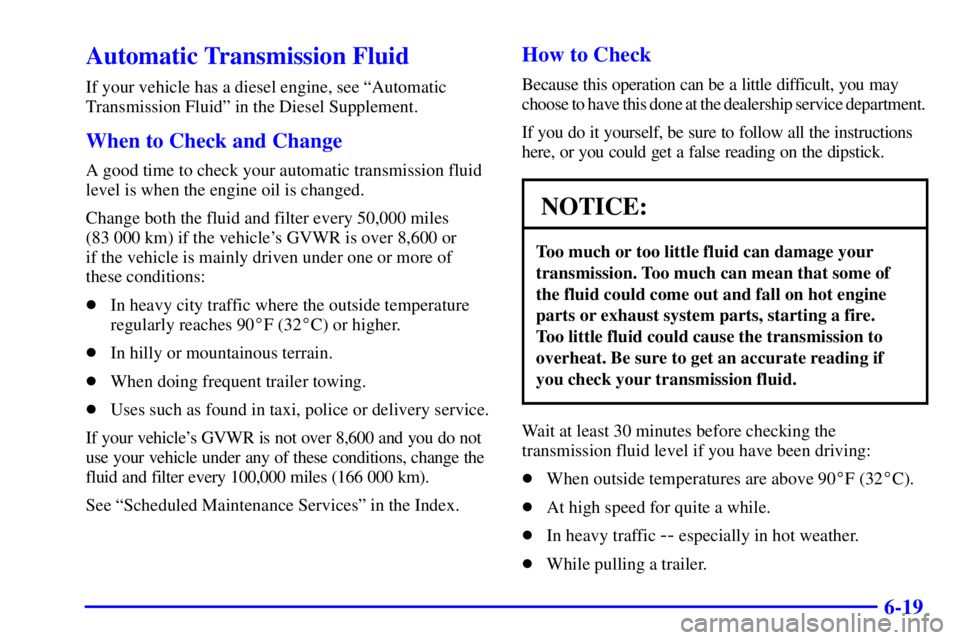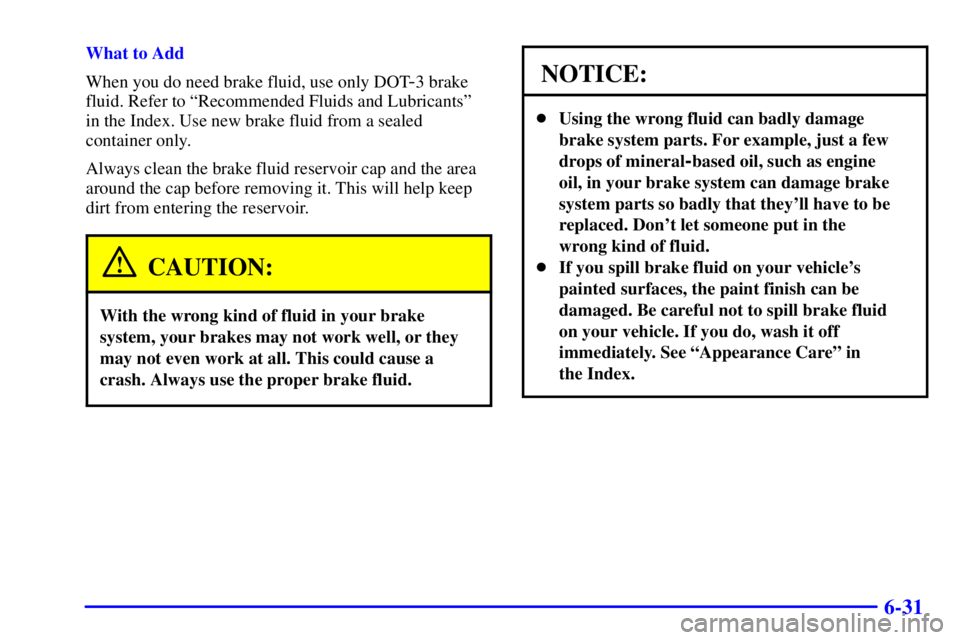Page 282 of 411
6-15
As in the chart shown previously, SAE 5W-30 is best for
your vehicle. However, you can use SAE 10W
-30 if it's
going to be 0�F (
-18�C) or above. These numbers on an
oil container show its viscosity, or thickness. Do not use
other viscosity oils, such as SAE 20W
-50.
NOTICE:
Use only engine oil with the American Petroleum
Institute Certified For Gasoline Engines
starburst symbol. Failure to use the
recommended oil can result in engine damage not
covered by your warranty.
GM Goodwrench� oil meets all the requirements for
your vehicle.
If you are in an area where the temperature falls
below
-20�F (-29�C), consider using either an
SAE 5W
-30 synthetic oil or an SAE 0W-30 oil. Both
will provide easier cold starting and better protection for
your engine at extremely low temperatures.
Engine Oil Additives
Don't add anything to your oil. The recommended oils
with the starburst symbol are all you will need for good
performance and engine protection.
Page 283 of 411

6-16 When to Change Engine Oil
If any one of these is true for you, use the short trip/city
maintenance schedule:
�Most trips are less than 5 miles (8 km). This is
particularly important when outside temperatures are
below freezing.
�Most trips include extensive idling (such as frequent
driving in stop
-and-go traffic).
�You frequently tow a trailer or use a carrier on top of
your vehicle.
�The vehicle is used for delivery service, police, taxi
or other commercial application.
Driving under these conditions causes engine oil to
break down sooner. If any one of these is true for your
vehicle, then you need to change your oil and filter
every 3,000 miles (5 000 km) or 3 months
-- whichever
occurs first.
If none of them is true, use the long trip/highway
maintenance schedule. Change the oil and filter every
7,500 miles (12 500 km) or 12 months
-- whichever
occurs first. Driving a vehicle with a fully warmed
engine under highway conditions will cause engine oil
to break down slower.
What to Do with Used Oil
Used engine oil contains certain elements that may be
unhealthy for your skin and could even cause cancer.
Don't let used oil stay on your skin for very long. Clean
your skin and nails with soap and water, or a good hand
cleaner. Wash or properly throw away clothing or rags
containing used engine oil. See the manufacturer's
warnings about the use and disposal of oil products.
Used oil can be a threat to the environment. If you
change your own oil, be sure to drain all the oil from the
filter before disposal. Never dispose of oil by putting it
in the trash, pouring it on the ground, into sewers, or
into streams or bodies of water. Instead, recycle it by
taking it to a place that collects used oil. If you have a
problem properly disposing of your used oil, ask your
dealer, a service station or a local recycling center
for help.
Page 286 of 411

6-19
Automatic Transmission Fluid
If your vehicle has a diesel engine, see ªAutomatic
Transmission Fluidº in the Diesel Supplement.
When to Check and Change
A good time to check your automatic transmission fluid
level is when the engine oil is changed.
Change both the fluid and filter every 50,000 miles
(83 000 km) if the vehicle's GVWR is over 8,600 or
if the vehicle is mainly driven under one or more of
these conditions:
�In heavy city traffic where the outside temperature
regularly reaches 90�F (32�C) or higher.
�In hilly or mountainous terrain.
�When doing frequent trailer towing.
�Uses such as found in taxi, police or delivery service.
If your vehicle's GVWR is not over 8,600 and you do not
use your vehicle under any of these conditions, change the
fluid and filter every 100,000 miles (166 000 km).
See ªScheduled Maintenance Servicesº in the Index.
How to Check
Because this operation can be a little difficult, you may
choose to have this done at the dealership service department.
If you do it yourself, be sure to follow all the instructions
here, or you could get a false reading on the dipstick.
NOTICE:
Too much or too little fluid can damage your
transmission. Too much can mean that some of
the fluid could come out and fall on hot engine
parts or exhaust system parts, starting a fire.
Too little fluid could cause the transmission to
overheat. Be sure to get an accurate reading if
you check your transmission fluid.
Wait at least 30 minutes before checking the
transmission fluid level if you have been driving:
�When outside temperatures are above 90�F (32�C).
�At high speed for quite a while.
�In heavy traffic
-- especially in hot weather.
�While pulling a trailer.
Page 291 of 411

6-24
A 50/50 mixture of clean, drinkable water and
DEX
-COOL� coolant will:
�Give freezing protection down to
-34�F (-37�C).
�Give boiling protection up to 265�F (129�C).
�Protect against rust and corrosion.
�Help keep the proper engine temperature.
�Let the warning lights and gages work as
they should.
NOTICE:
When adding coolant, it is important that you use
only DEX
-COOL� (silicate-free) coolant.
If coolant other than DEX-COOL is added to the
system, premature engine, heater core or
radiator corrosion may result. In addition, the
engine coolant will require change sooner
-- at
30,000 miles (50 000 km) or 24 months,
whichever occurs first. Damage caused by the use
of coolant other than DEX
-COOL� is not
covered by your new vehicle warranty.
What to Use
Use a mixture of one-half clean, drinkable water and
one
-half DEX-COOL� coolant which won't damage
aluminum parts. If you use this coolant mixture, you
don't need to add anything else.
CAUTION:
Adding only plain water to your cooling system
can be dangerous. Plain water, or some other
liquid such as alcohol, can boil before the proper
coolant mixture will. Your vehicle's coolant
warning system is set for the proper coolant
mixture. With plain water or the wrong mixture,
your engine could get too hot but you wouldn't
get the overheat warning. Your engine could
catch fire and you or others could be burned.
Use a 50/50 mixture of clean, drinkable water
and DEX
-COOL� coolant.
Page 298 of 411

6-31
What to Add
When you do need brake fluid, use only DOT
-3 brake
fluid. Refer to ªRecommended Fluids and Lubricantsº
in the Index. Use new brake fluid from a sealed
container only.
Always clean the brake fluid reservoir cap and the area
around the cap before removing it. This will help keep
dirt from entering the reservoir.
CAUTION:
With the wrong kind of fluid in your brake
system, your brakes may not work well, or they
may not even work at all. This could cause a
crash. Always use the proper brake fluid.
NOTICE:
�Using the wrong fluid can badly damage
brake system parts. For example, just a few
drops of mineral
-based oil, such as engine
oil, in your brake system can damage brake
system parts so badly that they'll have to be
replaced. Don't let someone put in the
wrong kind of fluid.
�If you spill brake fluid on your vehicle's
painted surfaces, the paint finish can be
damaged. Be careful not to spill brake fluid
on your vehicle. If you do, wash it off
immediately. See ªAppearance Careº in
the Index.
Page 334 of 411
6-67
NAME CIRCUITS PROTECTED
ETC Electronic Throttle Control
RR BLOWER Rear Auxiliary Blower
Motor Relays
CNG Compressed Natural Gas
ENG
-I Heated O2 Sensors, Mass Air
Flow Sensor, Evap Canister Purge
Valve, Crankshaft Position Sensor,
Secondary Air Injection Relay
(Diesel), Water in Fuel Sensor
(Diesel), Fuel Heater (Diesel),
Glowplug Relay (Diesel),
Wastegate Solenoid (Diesel)
ECM
-I Ignition Coil, Camshaft Position
Sensor, VCM, Fuel Injectors,
Coil Driver
IGN
-E Air Conditioning Clutch Relay
SPARE Spare Fuse
SPARE Spare Fuse
SPARE Spare FuseNAME CIRCUITS PROTECTED
A/C Air Conditioning Clutch Relay
HORN Horn Relay, Underhood Lamp(s)
ECM
-B Fuel Pump Relay, VCM, PCM,
Fuel Pump and Engine Oil
Pressure Switch
SPARE Spare Fuse
SPARE Spare Fuse
AUX A Upfitter Provisions
AUX B Upfitter Provisions
A/C RELAY Air Conditioning
HORN RELAY Horn
A.I.R. RELAY Air
FUEL
PUMP RELAYFuel Pump
STARTER
RELAYStarter
ABS EXPORT
RELAYABS Export
Page 337 of 411
6-70 Wheel Nut Torque
MODEL TORQUE
All
140 lb
-ft (190 N´m)
Cooling System Capacity
ENGINE VIN QTY Without Rear Heater QTY With Rear Heater
ªVORTECº 4300 V6 W 11.0 quarts (10.4 L) 14.0 quarts (13.2 L)
ªVORTECº 5000 V8 M 17.0 quarts (16.0 L) 20.0 quarts (18.9 L)
ªVORTECº 5700 V8 R 17.0 quarts (16.0 L) 20.0 quarts (18.9 L)
ªVORTECº 8100 V8 G 23.0 quarts (21.8 L) 26.0 quarts (24.6 L)
After refill, the level MUST be checked as outlined under ªEngine Cooling Systemº in Section 5.
Engine Oil Capacity
ENGINE VIN Quantity
ªVORTECº 4300 V6 W 4.5 quarts (4.3 L)
ªVORTECº 5000 V8 M 5.0 quarts (4.8 L)
ªVORTECº 5700 V8 R 5.0 quarts (4.8 L)
ªVORTECº 8100 V8 G 6.5 quarts (6.15 L)
Page 339 of 411

6-72
Normal Maintenance Replacement Parts
Replacement Parts
Replacement part numbers listed in this section are based on the latest information available at the time of printing,
and are subject to change. If a part listed in this manual is not the same as the part used in your vehicle when it was
built, or if you have any questions, please contact your GM dealer.
These specifications are for information only. If you have any questions, see the service manual for the chassis or
refer to the body manufacturer's publications.
EngineªVORTECº 4300
V6ªVORTECº 5000
V8ªVORTECº 5700
V8ªVORTECº8100
V8
VIN W M R G
Oil Filter PF47 PF1218 PF1218 PF454
Engine Air Cleaner Filter * A917C A917C A917C A917C
PCV Valve CV769C CV769C CV769C **
Spark Plugs
41
-932 41-932 41-932 TJ14R-P15
Fuel Filter GF481 GF481 GF481 GF481
Radiator Cap RC36 RC36 RC36 RC36
* Replace with ACDelco
� Air Filter, Part No. A917C and for severe dusty conditions, use ACDelco� Air Filter,
Part No. 1236C.
**8100 V8 has an internal PCV which does not require replacement.